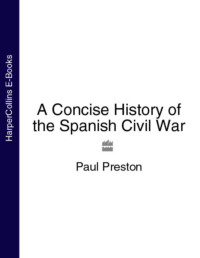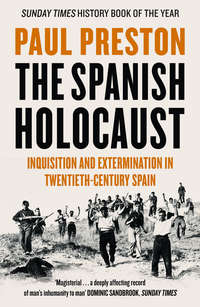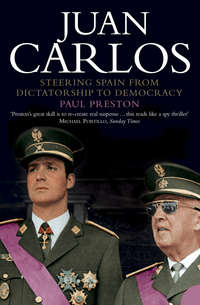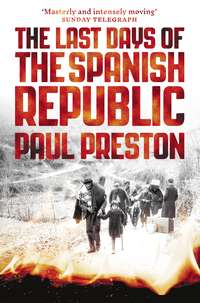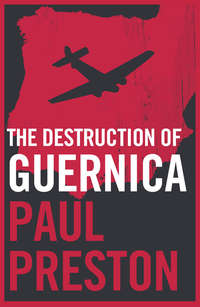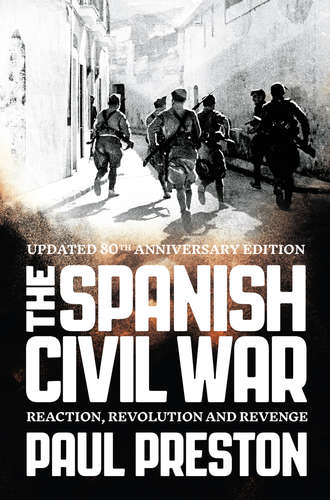
Полная версия
The Spanish Civil War: Reaction, Revolution and Revenge
Elections were announced for February. Unsurprisingly, the election campaign was fought in a frenetic atmosphere. Already, in late October, Gil Robles had requested a complete range of Nazi anti-Marxist propaganda pamphlets and posters, to be used as a model for CEDA publicity material. In practical terms, the right enjoyed an enormous advantage over the left. Rightist electoral finance dramatically exceeded the exiguous funds of the left. Ten thousand posters and fifty million leaflets were printed for the CEDA. They presented the elections in terms of a life-or-death struggle between good and evil, survival and destruction. The Popular Front based its campaign on the threat of fascism, the dangers facing the Republic and the need for an amnesty for the prisoners of October. The elections held on 16 February resulted in a narrow victory for the Popular Front in terms of votes, but a massive triumph in terms of power in the Cortes.
The left had won despite the expenditure of vast sums of money – in terms of the amounts spent on propaganda, a vote for the right cost more than five times one for the left. Moreover, all the traditional devices of electoral chicanery had been used on behalf of the right. Because the election results represented an unequivocal statement of the popular will, they were taken by many on the right as proving the futility of legalism and ‘accidentalism’. The savagery of rightist behaviour during the last two years ensured that the left’s tactical error of 1933 was unlikely to be repeated. The hour of the ‘catastrophists’ had struck. The CEDA’s youth sections and many of the movement’s wealthy backers were immediately convinced of the necessity of securing by violence what was unobtainable by persuasion. The elections marked the culmination of the CEDA attempt to use democracy against itself. This meant that henceforth the right would be more concerned with destroying the Republic than with taking it over. Military plotting began in earnest.
There was an almost instant return to the rural lockout of 1933 and a new aggression from industrialists. The rural and industrial working classes were equally militant, determined to secure some redress for the anti-union repression of the bienio negro from November 1933 to November 1935. Helpless in the midst of the conflict stood the government, weak and paralysed. Indeed, the central factor in the spring of 1936 was the fatal weakness of the Popular Front cabinet. The weakness was born not just of right-wing hostility but even more of the fact that it was in no meaningful sense representative of the electoral coalition which had voted it into power. In turn, that was the consequence of the ambiguity of PSOE attitudes to the Republic in the wake of the disappointments of 1931–3 and the suffering of the bienio negro. While Prieto was convinced that the situation demanded Socialist collaboration in government, Largo Caballero, fearful of a rank-and-file drift to the anarcho-syndicalist CNT, insisted that the liberal Republicans govern alone. He fondly believed that the Republicans should carry out the Popular Front electoral programme until they reached their bourgeois limitations. Then, in his fanciful scenario, they would be obliged to make way for an all-Socialist government. He used his immense influence to prevent the participation in the government of the more realistic Prieto. In consequence, only Republicans sat in the cabinet.
Largo Caballero’s revolutionism was never more than verbal but his rhetoric was enough to intensify the fears of a middle class already terrified by rightist propaganda and increasing levels of disorder on the streets. In the south, demonstrations in favour of amnesty for the prisoners of 1934 frequently turned into acts of vandalism against churches and the property of the rich. The task of pacification and reconciliation facing Azaña was enormous given the simmering hatred left by the previous two years. On 9 March, Falangist gunmen in Granada attacked a group of workers and their families, wounding many women and children. On the following day, during a strike called in protest, the local headquarters of the Falange and Acción Popular, the offices of the right-wing newspaper Ideal and two churches were set on fire. On 12 March, Falangist gunmen tried to assassinate Luis Jiménez Asúa, the architect of the Constitution. On 16 March, Largo Caballero’s house was fired on by another rightist terror squad. Azaña’s cabinet was barely equal to the problems it faced. The likeable Minister of the Interior, Amós Salvador, lacked the will to control the spiral of provocation and reprisal. As long as Azaña remained Prime Minister, the government’s authority could just be maintained.
Unfortunately, in April and May there was to occur a series of events which gave credence to the view that the most malignant of fates presided over Spain’s destiny. In order to put together an even stronger team, Azaña and Prieto plotted to remove the more conservative Alcalá Zamora from the presidency. Alcalá Zamora was constantly meddling in the work of the government and had little liking for Azaña. He had virtually no support since the left could not forgive him for permitting the entry of the CEDA into the government in October 1934 and the right could not forgive him for failing to invite Gil Robles to be Prime Minister at the end of 1935. In the Cortes on 7 April, Azaña and Prieto combined to have him impeached on the grounds that he had exceeded his constitutional powers in dissolving the Cortes. The removal of Alcalá Zamora seemed to open up the prospect of overcoming the difficulties caused by Largo Caballero’s hostility to Socialist participation in government. Prieto and Azaña had the skill and the popularity to stabilize the tense situation of the spring of 1936. With one as Prime Minister and the other as President, it might have been possible to maintain reform on a scale to diminish left-wing militancy while dealing determinedly with right-wing conspiracy and terrorism.
In the hope of putting a strong team at the head of the Republican state, neither man considered the consequences of neither of them being able to lead the cabinet. The first part of the plan worked but not the second. Azaña was elevated to the presidency on 10 May and immediately asked Prieto to form a government. He had detailed plans for social reforms and for a crackdown on the extreme right. However, he needed the backing of Largo Caballero, who controlled large sections of the Socialist movement – he was president of the UGT, of the largest section of the party, the Agrupación Socialista Madrileña, and also of the parliamentary party which he ruled with a rod of iron. Prieto faced his fellow parliamentary deputies twice, on 11 and 12 May. He knew when he had backed Azaña for the presidency that Largo Caballero and his followers would refuse to support a government under his premiership. He could have formed a government with the backing of the Republicans and about a third of the Socialist deputies. However, when faced with the prospect of splitting the party to which he had devoted his life, he could not do so. It was, at best, a mixture of weakness and decency; at worst, of defeatism and irresponsibility. Azaña had been removed from the cabinet and would now be replaced by a feeble substitute, his friend Santiago Casares Quiroga. Largo Caballero remained naïvely confident that, if what he saw as the inevitable transfer of power from an exclusively Republican to an exclusively Socialist cabinet provoked a Fascist or military uprising, it would be defeated by the revolutionary action of the masses.
The consequences could not have been worse. A shrewd and strong Prime Minister was lost. To make matters worse, on assuming the presidency, Azaña increasingly withdrew from everyday politics. He took enormous delight in his ceremonial functions, in the restoration of monuments and palaces and in being a patron of the arts. His replacement as Prime Minister, Casares Quiroga, suffering from tuberculosis, was hardly the man to provide the determined leadership necessary in the circumstances.
Immediately the election results were known, exuberant workers had set about reaping revenge for the starvation and wage cuts of the bienio negro and for the brutal repression which had followed the Asturian rising. In any case, natural disaster intensified the social misery of the south. After drought in 1935, 1936 began with heavy rainstorms which decimated olive, wheat and barley production. Unemployment was rocketing and the election results had raised the hopes of the braceros to fever pitch. Throughout March, the Socialist land-workers’ union, the FNTT, encouraged its members to take at its word the new government’s proclaimed commitment to rapid reform. In Salamanca and Toledo, Córdoba and Jaén, there were invasions of estates by peasants who stole olives or cut down trees. The most substantial land seizures took place in Badajoz. On 29 May, in Yeste in the province of Albacete, seventeen peasants were killed, and many others wounded, by the Civil Guard. They had attempted to chop wood on land that had once belonged to the village and been taken from it by legal subterfuge in the nineteenth century. In general, what most alarmed the landlords was the assertiveness of labourers whom they expected to be servile but now found to be determined not to be cheated out of reform as they had between 1931 and 1933. Many landowners withdrew to Seville or Madrid, or even to Biarritz or Paris, where they enthusiastically joined, financed or merely awaited news of ultra-rightist plots against the Republic.
Many sectors of right-wing society were anxious to role back the reforms associated with the Spanish Republic. This was most starkly clear in the rural areas where the Republic had raised hopes that challenged the existing social balance. It was also true in terms of the Republic’s concessions to regional nationalisms, which unleashed military centralism, and of Republican efforts to break the educational and religious monopolies held by the Catholic Church. One change initiated by the Republic which was less dramatic in its immediate impact yet ignited deep-seated hostility was the movement towards the emancipation of women. The Republic gave much to women but Franco’s victory in the Spanish Civil War would take away even more.
In the five and a quarter years before the right-wing backlash culminated in the military coup of 18 July 1936, cultural and educational reform had transformed the lives of many Spaniards, particularly women. Before 1931, the Spanish legal system had been astonishingly retrograde – women were not permitted to sign contracts, to administer businesses or estates or to marry without risk of losing their jobs. The Republican Constitution of December 1931 gave them the same legal rights as men, permitting them to vote and to stand for parliament and legalizing divorce. Pressure for the female vote had come not from any mass women’s movement but from a tiny elite of educated women and some progressive male politicians, most notably in the Socialist Party. Accordingly, much of this legislation was excoriated as ‘godless’ by a majority of Catholic women influenced by their priests. For this reason, the right was far more successful than the left in rallying newly emancipated female voters to its cause. In any case, in the period from 1931 to 1936, women of both the left and the right were mobilized politically and socially as never before. They were involved in electoral campaigns, trade union committees, protest demonstrations and in the educational system, both through the massive expansion of primary schooling and the opening up of the universities.
Nevertheless, public life remained a predominantly male precinct. The woman rash enough to put her head over the parapet and intrude upon the patriarchal territory of politics faced accusations of being brazen and – as happened to both Margarita Nelken and Dolores Ibárruri – from there it was but a short step to being regarded as a whore. Such misogyny was less prevalent in the more cosmopolitan atmosphere of the left in Madrid and Barcelona, although even there it was not uncommon. On the right, female independence was heavily frowned upon. The further one travelled from the metropolis, the more acute the problem became.
Конец ознакомительного фрагмента.
Текст предоставлен ООО «ЛитРес».
Прочитайте эту книгу целиком, купив полную легальную версию на ЛитРес.
Безопасно оплатить книгу можно банковской картой Visa, MasterCard, Maestro, со счета мобильного телефона, с платежного терминала, в салоне МТС или Связной, через PayPal, WebMoney, Яндекс.Деньги, QIWI Кошелек, бонусными картами или другим удобным Вам способом.


